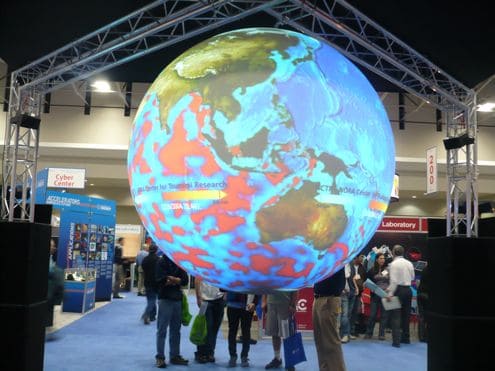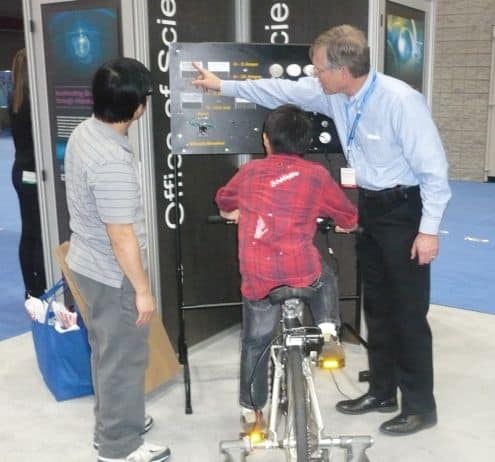
Science on a sphere
By Margaret Harris in Washington, DC
No trip to the AAAS meeting would be complete without a tour of the exhibit hall, which for the past two days has been buzzing with visitors to “Family Science Days”, a public outreach-oriented event running in parallel with the more technical seminars.
One of the most eye-catching exhibits was the National Oceanic and Atmospheric Administration’s Science on a Sphere, which pretty much does what it says on the tin. The Sphere is the brainchild of Alexander McDonald, director of NOAA’s Earth Systems Research Laboratory, and there are now over 250 datasets that can be displayed on it. In this photo, it’s illustrating the shock waves that spread around the globe after the Boxing Day tsunami of 2004, but I also saw depictions of ocean currents, aeroplane flight paths, global temperatures and the past week’s weather. According to exhibitor Jana Goldman, there’s even one in a science fiction museum in Seattle, Washington that displays the (hypothetical) features of a (fictional) alien planet – so it’s definitely a versatile beast!
Another exhibit that got a lot of traffic was the US Department of Energy’s set of bicycle-powered light bulbs, which is designed to teach kids (and maybe some adults) about the differences between voltage and current, and to demonstrate in a very physical way how much power it takes to light up an incandescent 50 W bulb compared with fluorescent and LED bulbs. The young gentleman in this photo, for example, was having real trouble getting the incandescent bulb to give off any light, but despite being a little too short for the pedals, he managed the LED bulb just fine.

Bicycle-powered light bulbs
For the bigger kids, exhibitor Steve Eckstrand keeps a 12 V, 300 W hairdryer on hand. “They can usually get the 50 W bulb working just fine, and one girl did manage to pedal hard enough to get a faint glow out of the 100 W bulb,” he says. “But nobody can do more than get the hairdryer sort of gently warm.”



